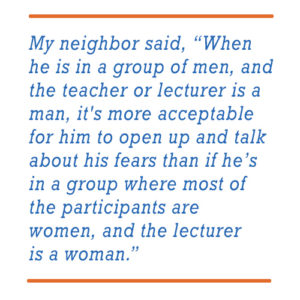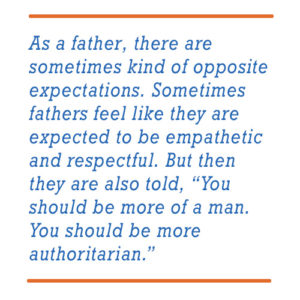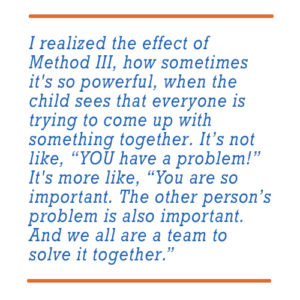
Oftentimes in P.E.T. classes the majority of the participants are mothers, and this is common around the world. However, Gordon Training International (GTI), has a P.E.T. Representative in the Czech Republic who’s changing that—and his story is pretty fantastic–and inspiring to say the least. Below is a brief interview with Mr. Jan Vavra and Sheryl Wilde, of GTI, about how he created a more dad-friendly approach, real-life examples of the P.E.T. skills in action and so much more!
Sheryl:
How did your P.E.T. for Dads course come about?
Jan:
I noticed that when I started my first courses, or P.E.T. programs, I saw there were more mothers. I often heard some women say, “Okay, my husband would need it, but he doesn’t want to participate.”
And one day I went with one of my neighbors by train. She was very interested in P.E.T., but she didn’t join us in the courses. She told me that her husband, that he was skeptical about alternative education, like Montessori.
My neighbor said, “When he is in a group of men, and the teacher or lecturer is a man, it’s more acceptable for him to open up and talk about his fears than if he’s in a group where most of the participants are women, and the lecturer is a woman.”
And I said, “Okay, that’s maybe a good idea. Maybe I could do something like that with the P.E.T. programs. It may help to get more men to participate, because it will be more acceptable.”
 I was afraid about doing it in isolation, just men, because I don’t like too much to separate things. I am a therapist and I see sometimes it creates more misunderstanding than understanding afterward, but I said maybe it will help P.E.T. programs for men to participate.
I was afraid about doing it in isolation, just men, because I don’t like too much to separate things. I am a therapist and I see sometimes it creates more misunderstanding than understanding afterward, but I said maybe it will help P.E.T. programs for men to participate.
I tried the first P.E.T. course for fathers and I found only a few, like five fathers or something. But I said okay, I will try it and I will see. And I saw it was useful to do it in the men’s group. The last one was for 12 men. Every time there are more participants, so it is growing.
Sheryl:
You mentioned earlier that you found the courses for fathers useful. Can you tell me more about that? How was it useful?
Jan:
I saw the basic idea, that it will help to open more training for the fathers. I saw that it’s working, that they share.
During the last course, I was surprised. We did this first introduction exercise, in a circle, and they, the fathers, started to talk so much. It was like one hour!
Then I said, “Okay we have to go through the program,” But everyone was talking about, “I had very authoritative parents and they beat me up.” Or someone said, “I had very liberal parents and it’s like opposite.” And they started to discuss all this and everyone was talking about childhood.
The fathers started so much sharing! I haven’t seen so much sharing at any program, even where there were mostly women.
So I was saying, “Okay, it helps to open up and share and talk about what’s not easy for them to do as a parent.”
As a father, there are sometimes kind of opposite expectations. Sometimes fathers feel like they are expected to be empathetic and respectful. But then they are also told, “You should be more of a man. You should be more authoritative.”
They are lost. They don’t know if it’s better to be more this Gordon style parent or if they should be more like, “Okay, let’s do this!” Like they make the rules in the family.
So they are sometimes lost. They see the opposite expectations. When they start to be more sensitive, then someone says, “You maybe are too sensitive.” And when they try to be authoritative, “Maybe you are too hard.” So it’s confusing now. In our society, what’s the father’s role?
I think these ideas of Thomas Gordon really help, because it’s very structured and there are many rational arguments. What are the tangible effects of parenting if you use punishment? What is the effect?
Often I saw that they really understood, “Okay, it does make sense. Maybe I don’t know how to do it, but it really is a very good structure.” And so that’s what I saw about the effects of the Gordon Model.
And there are some things which are quite clear. I’ve done three courses, and I see it again and again, that for fathers, they work a lot. They are not so used to being with children so much. And they come home late in the evening, or they come home on the weekend, and they are lacking the time for practicing the skills, or to have one-on-one time with their children.
 I think that they see the Gordon Model skills as useful, to have something working or effective. Because they see that if they don’t have the skills, there’s sometimes going to be some arguing, not good relations.
I think that they see the Gordon Model skills as useful, to have something working or effective. Because they see that if they don’t have the skills, there’s sometimes going to be some arguing, not good relations.
Sheryl:
Can you share some examples of how the fathers in your P.E.T. courses have used the skills?
Jan:
Yes, of course there are some examples. For example, Active Listening. Sometimes it’s not easy for people, not only men. It’s a very reversed form of communication skill for them. But they start to try it and they see they get to know more about their children, more and more.
I think mostly what I see as a result of P.E.T. is that the people start to be more aware of what they do. Sometimes they may not really see the results at first, but they start to realize, “Okay, I’m doing this. Maybe it has this influence or this result or this effect. And I am more aware that I am using the Communication Roadblocks.”
I remember one case from my P.E.T. course for fathers. The parents were struggling with sleeping. They had a 3-year-old son, and he was a night child. So, the parents were tired and wanted to sleep, but the son, he was like, “Okay, let’s do something!”
So it was not easy for them to sleep. But then the father said, after taking the P.E.T. course, he said he realized that it’s maybe a Needs Conflict and that his son could also consider the parent’s needs. So, the father said, “Okay, I’m going to sleep now. You can turn the lights off when you go to bed. I am going to bed now.” And the parents went to bed. And their son played for like five minutes and then realized, “It’s not fun.” And he went to sleep too.
When they tried to make him, “Go to the bed! Go to bed!” The son was like, “No, no, no.” But when they go to the bed, and say, “It’s okay if you want to be awake.” Then, when the parents went to bed, the son followed.
And the father was like, “Okay, I didn’t have this idea before, but when I thought about the Behavior Window from P.E.T., and about my needs, I had this idea, that I could say, ‘Okay, I’m going to bed now and you come to bed when you feel it’s right for you.’”
And the son decided very fast. I don’t know if he was afraid to be alone or something. But he went also to sleep.
Sheryl:
What have been your experiences with it since you’ve been using it with your children?
Jan:
My son was visiting a unique “Forest” kindergarten. So, I attended some days in the kindergarten. And I said, “Okay, I like it here. If I were a child, I would like to come here.”
While I was there, I worked with small children from three to five and I was trying these ideas, from Thomas Gordon, because they were crying. The parents left and the children cried and I said, “You are sad because your mother left.” And I found out it worked! Some of the children were missing their parents and crying. I sat with them for half an hour and talked about it, and through that, they really made a connection with me. And still now, they are like 10 years old, and they remember me and so it’s very powerful.
And they also then better react to what I want from them.
So it was for me the first proof that the Gordon Method worked, not only with my own child, but even with a child I’d just met for the first time.
I started trying to do Active Listening really precisely. And so, it helps more. And I found out more about the importance of our messages. And I started to realize that I was with my first son, maybe I was too permissive sometimes.
It also helps me more to go to my own needs. My experience is that it was much easier with my second son. He was from the beginning raised with the Gordon skills and so I communicated more with him from a really small age.
And I think he is really reacting to our messages and Active Listening. And when we do Method III, it’s very fast in helping to define the needs. So I think it really helps me to see both sides of the relationship and I think it helps to solve many situations in our family.
For me, it was the first time I realized that I have to also more reflect on my needs. That was the first effect on me.
And sometimes you have to change the relationship. It’s not easy in the beginning, but from the first time, I realized how Active Listening worked.
For example, when I had a problem in the morning, when we went somewhere, to kindergarten or something, I was stressed and I started to push my son. And he started to fight. And I found out that when I started to say, “Okay, you don’t want to go there. You just don’t want to wear your clothes or something,” that it works better. It takes the same time, but it’s a much better feeling. Maybe we were like 10 minutes late, but in much better condition.
So I found out, “Wow, if I push, it doesn’t work. If I actively listen, it’s maybe also taking some time, but the feeling is much better on both sides.” So it was my first experience and it worked.
Sheryl:
Can you share another example of how you have used the Gordon Model skills?
 Jan:
Jan:
I remember one example that was kind of strong for me. And there was some proof that it had some effect, I think. It was with my son, the oldest son, he was playing field hockey. He became a goalie, and it’s kind of, you know, a very responsible position. You are on the team, and you have to prove you are responsible. He was nervous the first time and he said, “I am very nervous. Help me.”
And I said, “I don’t know if I have some magic trick to help you, but I know Active Listening. I’ll try to do it with you.” Then I said, “Okay, you are very nervous. You feel very responsible. Yes?” He said, “Yes. Because if they get some goals, maybe they’ll laugh at me or they will say I am bad and I destroyed all of them.” And I said, “Okay, and it’s hard to be in this responsible position and you are afraid that you will be not so good in it.” He said, “Yes.” And he continued to talk more and more.
Then suddenly he said, “Okay, we can prepare. Let’s go get ready and have our breakfast,” I said, “Okay, we go.” Then he was in the match. And afterward the trainer said, “Yeah, he was very good. He was not nervous.”
I have another example. Our son is now seven and he’s in the first grade of school. He was kind of afraid of falling asleep alone at night. Sometimes he wanted us to be there and maybe we would read something together or something. He said, “I am afraid to be here alone.” But we stopped to like it because we were tired. We said, “Okay, we should do something about it, because you always want us to be there and we can’t always be there. We should do this like a Method III, to solve this conflict of needs.”
It was very strong, because for me it was one of the best Method III sessions we did. So we said, “Okay with this sleeping problem, we should do it as a Method III session.” And it really touched me because I didn’t like to fall asleep alone when I was a child. I had many anxieties and I never told my parents too much about it. They said it was my imagination. There are no monsters, and so on. So this Method III was very powerful because we said, “Okay, your need is to be with us, because you are afraid of something.”
And he said, “Yes. But it doesn’t make any sense, all the fears. Because it’s like, it’s changed 100 times. It’s all the time something new. But it’s not important what is it, because I am afraid.” And we said, okay. And he said, “It helps me to touch you when I fall asleep.” And we said, okay. Then my wife and I said, “We also need some time for us. We are tired and we want to do something on our own.” And I said, “I want to talk with mother also in the evening.”
And so we tried to come up with some solutions, but he always said, “It doesn’t work.” Then I suddenly realized something, and it was very strong for me. I said, “Okay, but when you were alone at someone else’s house, and you slept there, you never said it was a problem.” No one said, “He can’t sleep or he was crying.” And he said, “Yes, I am able to do it, but I don’t like it.” So I said, “Yeah, but that’s not fair, because I also can manage to be with you every night, but I don’t like it either. So it’s the same.”
He said, “Yeah, that’s true. It’s not fair.” And I said, “Okay, maybe we can try one night together, then one night you can be alone.” He said, “Yeah, it is a great idea. I can manage it when it’s sometimes, not every time.” I said, “Okay. So we can be with you one night and then one time, or two times, you can be alone. Practice. Then we can again be there with you.”
Then we came up with many ideas of what might help him. And his older brother also came up with ideas. He said he could paint for him some talismans or kind of magical protection. So they came up with these ideas. And we recorded him some songs, what his mother sometimes sings to help him fall asleep, and many other things. And he really managed to do it. Then he said the next day, “Okay, today I can also be alone.” It really started to work.
 I realized the effect of Method III, how sometimes it’s so powerful, when the child sees that everyone is trying to come up with something together. It’s not like, “YOU have a problem!” It’s more like, “You are so important. The other person’s problem is also important. And we all are a team to solve it together.”
I realized the effect of Method III, how sometimes it’s so powerful, when the child sees that everyone is trying to come up with something together. It’s not like, “YOU have a problem!” It’s more like, “You are so important. The other person’s problem is also important. And we all are a team to solve it together.”
If I had something like this happen in my childhood, it was mostly like, “Okay, I understand you have a problem, but what we can do? Not too much. You should do like this.” We didn’t try to come up with all these ideas and it didn’t feel like everyone was equally important in the family.
So, using Method III, it was nice. And it really helped.
Sheryl:
How do your children react when you use Active Listening and Method III?
Jan:
I think they react good – when I am good.
Sometimes I’m not able to do it still. Even when I do, there is sometimes the voice in my head that says, “Okay, you are not a good practitioner of the Gordon skills, and you teach.” Like I criticize myself and then I say, “Okay, so stop criticizing myself.” It’s hard. But I think children react very good sometimes.
It’s like that for Active Listening. I see that sometimes I had an idea that we should really come to some solution, because I am this person who wants to know more and more, because it’s my profession. But I realized it doesn’t have to be like this. It’s enough when I actively listen. He said something and I said, “Okay.” And not continue.
It was important for me to respect that there is sometimes not this kind of happy ending, like, “Okay, now I realize what’s the problem and now it’s solved.” But it was for me the kind of experience that sometimes they are not really wanting to share something, and it’s good to respect it.
I think that’s also the quality of this Gordon Model. I realized also that I am more relaxed and I don’t have to solve everything. I can let it more flow or trust that it will be good. That I’m not so important.
Sheryl:
Is there anything else that you would like to share about P.E.T. for fathers or just P.E.T. in general that you’ve experienced?
Jan:
I had the idea that I have to make them to know all the training by the end of the course. Then I found out that maybe if they realize they can Active Listen, they will be successful. It’s very good. And if they don’t know the rest, they will be successful in one thing. Then they will come slowly to other things.
I’m very happy when I see, “Yeah, now they know how to Active Listen in the last lesson,” That’s maybe what I want to say to people who have taken the course. That it’s really good and not to be scared if they don’t know everything after reading the book or attending P.E.T. classes.
There’s so much to learn and it’s my learning experience that it’s good to be joyful when I know one skill and then I can add another later. And that in eight weeks, it’s not really sometimes easy to change it all – to say a good iMessage, use good Active Listening, and know how to do Method III really precisely. It all comes with time and the important thing is not to give up.

